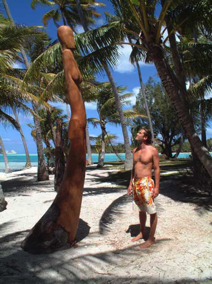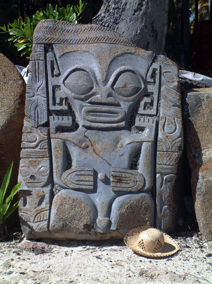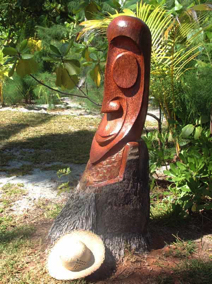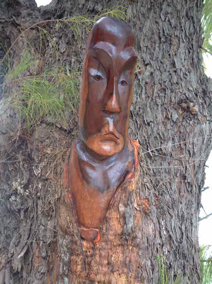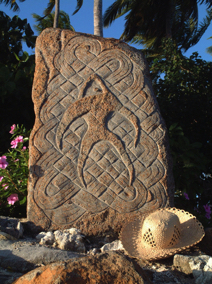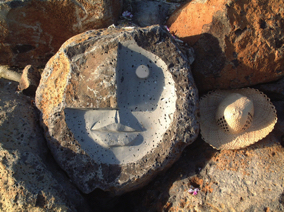A Man and his Island:
TEVA VICTOR
: : Teva Victor is a Tiki carver from Bora Bora who owns (and rents out) his own private island. : :
MaiTai : : Do the pale jet-setters that visit your island ever show an interest in your carving talents?
TEVA : : The guests that come to Private Island are not that “jet-set,” you know. They are mainly common people like you and I. And they definitely appreciate the art on the island. I even made a treasure map for kids, with tiny pictures of each sculpture, and they have to find them and position them correctly on the map. Even when there are no kids, the adults bring out their inner child, and I see them, map in hand, wandering around the island...
MT : : What do you consider to be your primary occupation: carver or hotelier?
TV : : I do both with great heart but I guess that carver would be the one, mainly because, even when I do other things, I often think of different carving projects.
MT : : Is Tiki carving passed down from father to son?
TV : : For me, it was not passed on. My father is a French scientist (polar explorer and ethnologist Paul Emile Victor) but also a real artist—mainly drawing and painting. I remember that he told me once: “If you have even just one minute, then pick up a piece of paper and a pencil and draw whatever you have in front of you.” So I did. It is very important to be able to draw well in order to sculpt, I think. So he did pass on to me his eyes and part of his talent.
MT : : Have you ever entered Tiki carving competitions to show neophytes how it’s done?
TV : : I don’t have this pretension. I do my art, and that’s all. I do it for myself first, not so that it pleases everyone, for I know that it is not possible. My Tiki carvings are partly traditional sometimes, but definitely all are personal. It is not interesting for me to just recreate something that already exists. It has to have part of me in it, and that is exactly what makes it powerful.
MT : : Do you export your carvings?
TV : : So far I haven’t exported except for a big rock sculpture that I did in Brittany, in France. My carvings are generally massive, and either on living trees, or dead trees that are still rooted to the ground, or on big rocks.
MT : : Where are your sculptures displayed in Bora Bora?
TV : : They are mainly displayed on my private islet in the Bora Bora lagoon.
MT : : How is your carving different from traditional models? Do you detract from original designs and go modern, selon vos désires?
TV : : Indeed, I believe it is important to always create “personally,” and that is what makes it a different piece every time. I have more traditional pieces, and others are totally offset and just modern.
MT : : What tools do you use? Chainsaw, or chisel and mallet? I suppose chainsaw is the main equipment used nowadays.
TV : : I use both, and any other means I can think of. Chainsaw is faster, but not that easy, or at least not for me… so I use it just for getting the big parts out. Then I use chisel and mallet, and even electrical sanding tools. As for the rock sculpting, I have hand tools which I use a lot, and electrical and pneumatic tools too.
MT : : Explain to us your process. Do you use a blueprint or design first? What type of wood do you use?
TV : : Most of my sculptures first emerge in my thoughts. Generally, I first have the tree: a dead coconut tree, or an area on a living “Aito” metalwood tree, or an order from someone who proposes a specific tree. Then for the next few days, or even weeks, an idea will emerge and will be present in my head at all times, consciously or unconsciously. I know it is there. It gets detailed, and “polished” in a way… attuned to what I want. I often draw sketches but mostly, it gets close to perfect in my head first.
MT : : What about painting the eyes? Wouldn’t be très catholique, n’est pas?
TV : : Here they do not paint the eyes, and I don’t either. But I use incrustations with a whole bunch of different objects, depending on the effect I want. Even modern objects… One piece has boat anodes for eyes.
MT : : What is the inspiration for your carvings? Some American Tiki carvers can get designs from Tiki mugs or original Polynesian art.
TV : : I have quite a few books on Polynesian and Pacific art which I glance through often, but sometimes it comes from nature directly, or an apparition in a dream or a meditation.
MT : : Which is your favourite Tiki god to carve? The superstitious mystique is gone I suppose.
TV : : I do not specifically sculpt already existing Tiki gods. They do not represent any gods in my belief, but represent themselves. I think that we are all gods, and have our destiny and will in our own hands… no need to take the power out of ourselves and put it into something else.
MT : : Do you have apprentices to whom you can pass along the tradition? Or can anyone who is dexterous with a chainsaw do this? Have any of your guests tried?
TV : : So far I have not taken an apprentice, the main reason being that I place my family as the top priority… so I carve only when I have the time. But there once was a family who rented our guest house, and the 20 year old son was really enthusiastic. So I lent him some tools, a piece of wood, and gave some advice from time to time, and was really pleasantly surprised at his work.
MT : : Do you make masks or any other art forms?
TV : : There are no masks in French Polynesian traditions but I work a lot with faces… faces with expressions, faces which are part Tiki.
MT : : Are there new burgeoning, local Tiki artists we should know about?
TV : : There is in Bora Bora a great carver and painter named Teia Teaue, who sculpts very powerful stuff, and paints a mixture of tradition with modern means.
MT : : Is there a movement in your area to preserve or restore original, old Tikis… to protect them from the elements?
TV : : There are no real ancient Tikis any more. Or at least not in Bora Bora. Only ancient engravings on rocks of marae. Those are not really protected much, unfortunately.
MT : : Do you see the irony of American-made 1950s Tikis sold and showcased in resorts in Tahiti/ Samoa?
TV : : It is indeed ironic, but the original, local art does not cease to exist. There are a lot of old-style Tiki carvers in the Marquesas Islands. It’s just the hotels’ choice to feature one artist or another...
MT : : Is there a fraternity or “guild” of Tiki carvers?
TV : : There is no “union” or grouping of sculptors that I know of. I have friends who sculpt on Bora Bora or elsewhere, and we are always happy to see what the other has done lately, and we talk about it, but that is basically all it amounts to.
MT : : Finally, tell me a bit about your Private Island resort.
TV : : On our four-acre private island, we only have two houses: One is ours, and the other—located on the other side of the island—is the guesthouse, which can house up to 5 people and is fully equipped with a kitchen, CD player with 50 CDs, a TV, DVD player, and a personal library. Guests are provided with kayaks to adventure around the islands and explore, and they can go snorkeling to see all the different corals and fish. There are a whole bunch of activities proposed on Bora Bora like shark feeding, scuba diving, jet skiing, jeep rides, horse back riding, and more. There are only us two on the island, so our guests have real privacy, but we often meet and talk.
MT : : I am curious to know how you came to own this island. Where is Motu Haapiti Rahi exactly—near Passe Te ava nui? Te ava nui must be where your name derives from…
TV : : I inherited the island. Motu Haapiti Rahi is north-west of Bora Bora. Te ava nui literally translates to Big Pass. Teva is the god who resides in those passes… the god that people would implore before leaving in order to have a safe trip… but I prefer “Prince of Travels.”
More info:
BP 551—98730 Bora Bora—Polynésie Française / Phone: (689) 74.24.73 / Fax: (689) 67.74.50
Mirella Bontempo © 2004
CLICK TO ENLARGE PHOTOS
